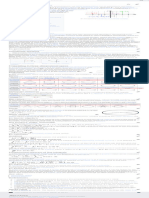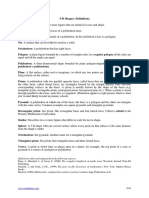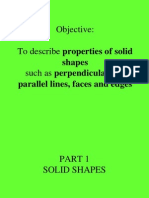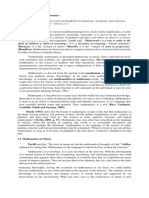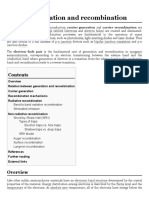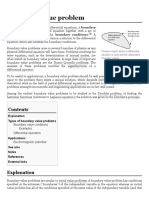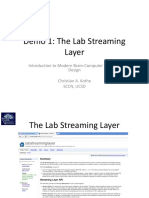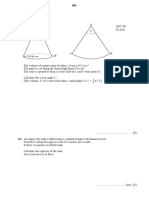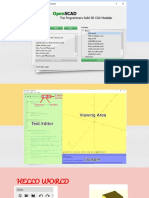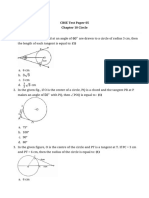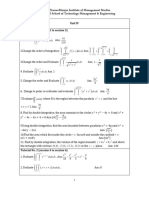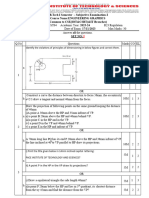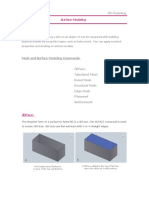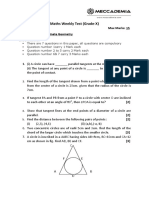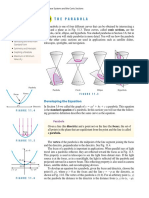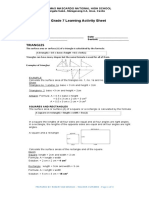Shape
A shape is the form of an object or its external boundary,
outline, or external surface, as opposed to other properties such
as color, texture or material type.
Contents
Classification of simple shapes
In geometry A children's toy used for learning
various shapes
Equivalence of shapes
Congruence and similarity
Homeomorphism
Shape analysis
Similarity classes
Human perception of shapes
See also
References
External links
Classification of simple shapes
Some simple shapes can be put into broad categories .
For instance, polygons are classified according to
their number of edges as triangles, quadrilaterals,
pentagons, etc. Each of these is divided into smaller
categories; triangles can be equilateral, isosceles,
obtuse, acute, scalene, etc. while quadrilaterals can be
rectangles, rhombi, trapezoids, squares, etc.
Other common shapes are points, lines, planes, and
conic sections such as ellipses, circles, and parabolas.
Among the most common 3-dimensional shapes are
polyhedra, which are shapes with flat faces; ellipsoids,
which are egg-shaped or sphere-shaped objects;
cylinders; and cones. A variety of polygonal shapes.
If an object falls into one of these categories exactly or
even approximately, we can use it to describe the shape of the object. Thus, we say that the shape of a
manhole cover is a disk, because it is approximately the same geometric object as an actual geometric
disk.
In geometry
�There are several ways to compare the shapes of two objects:
Congruence: Two objects are congruent if one can be transformed into the other by a sequence
of rotations, translations, and/or reflections.
Similarity: Two objects are similar if one can be transformed into the other by a uniform scaling,
together with a sequence of rotations, translations, and/or reflections.
Isotopy: Two objects are isotopic if one can be transformed into the other by a sequence of
deformations that do not tear the object or put holes in it.
Sometimes, two similar or congruent objects may be regarded as having a different shape if a
reflection is required to transform one into the other. For instance, the letters "b" and "d" are a
reflection of each other, and hence they are congruent and similar, but in some contexts they are not
regarded as having the same shape. Sometimes, only the outline or external boundary of the object is
considered to determine its shape. For instance, a hollow sphere may be considered to have the same
shape as a solid sphere. Procrustes analysis is used in many sciences to determine whether or not two
objects have the same shape, or to measure the difference between two shapes. In advanced
mathematics, quasi-isometry can be used as a criterion to state that two shapes are approximately the
same.
Simple shapes can often be classified into basic geometric objects such as a point, a line, a curve, a
plane, a plane figure (e.g. square or circle), or a solid figure (e.g. cube or sphere). However, most
shapes occurring in the physical world are complex. Some, such as plant structures and coastlines,
may be so complicated as to defy traditional mathematical description – in which case they may be
analyzed by differential geometry, or as fractals.
Equivalence of shapes
In geometry, two subsets of a Euclidean space have the same shape if one can be transformed to the
other by a combination of translations, rotations (together also called rigid transformations), and
uniform scalings. In other words, the shape of a set of points is all the geometrical information that is
invariant to translations, rotations, and size changes. Having the same shape is an equivalence
relation, and accordingly a precise mathematical definition of the notion of shape can be given as
being an equivalence class of subsets of a Euclidean space having the same shape.
Mathematician and statistician David George Kendall writes:[1]
In this paper ‘shape’ is used in the vulgar sense, and means what one would normally
expect it to mean. [...] We here define ‘shape’ informally as ‘all the geometrical
information that remains when location, scale[2] and rotational effects are filtered out
from an object.’
Shapes of physical objects are equal if the subsets of space these objects occupy satisfy the definition
above. In particular, the shape does not depend on the size and placement in space of the object. For
instance, a "d" and a "p" have the same shape, as they can be perfectly superimposed if the "d" is
translated to the right by a given distance, rotated upside down and magnified by a given factor (see
Procrustes superimposition for details). However, a mirror image could be called a different shape.
For instance, a "b" and a "p" have a different shape, at least when they are constrained to move
within a two-dimensional space like the page on which they are written. Even though they have the
same size, there's no way to perfectly superimpose them by translating and rotating them along the
page. Similarly, within a three-dimensional space, a right hand and a left hand have a different shape,
even if they are the mirror images of each other. Shapes may change if the object is scaled non-
�uniformly. For example, a sphere becomes an ellipsoid when scaled differently in the vertical and
horizontal directions. In other words, preserving axes of symmetry (if they exist) is important for
preserving shapes. Also, shape is determined by only the outer boundary of an object.
Congruence and similarity
Objects that can be transformed into each other by rigid transformations and mirroring (but not
scaling) are congruent. An object is therefore congruent to its mirror image (even if it is not
symmetric), but not to a scaled version. Two congruent objects always have either the same shape or
mirror image shapes, and have the same size.
Objects that have the same shape or mirror image shapes are called geometrically similar, whether or
not they have the same size. Thus, objects that can be transformed into each other by rigid
transformations, mirroring, and uniform scaling are similar. Similarity is preserved when one of the
objects is uniformly scaled, while congruence is not. Thus, congruent objects are always geometrically
similar, but similar objects may not be congruent, as they may have different size.
Homeomorphism
A more flexible definition of shape takes into consideration the fact that realistic shapes are often
deformable, e.g. a person in different postures, a tree bending in the wind or a hand with different
finger positions.
One way of modeling non-rigid movements is by homeomorphisms. Roughly speaking, a
homeomorphism is a continuous stretching and bending of an object into a new shape. Thus, a
square and a circle are homeomorphic to each other, but a sphere and a donut are not. An often-
repeated mathematical joke is that topologists cannot tell their coffee cup from their donut,[3] since a
sufficiently pliable donut could be reshaped to the form of a coffee cup by creating a dimple and
progressively enlarging it, while preserving the donut hole in a cup's handle.
A described shape has external lines that you can see and make up the shape. If you were putting you
coordinates on and coordinate graph you could draw lines to show where you can see a shape,
however not every time you put coordinates in a graph as such you can make a shape. This shape has
a outline and boundary so you can see it and is not just regular dots on a regular paper.
Shape analysis
The above-mentioned mathematical definitions of rigid and non-rigid shape have arisen in the field
of statistical shape analysis. In particular, Procrustes analysis is a technique used for comparing
shapes of similar objects (e.g. bones of different animals), or measuring the deformation of a
deformable object. Other methods are designed to work with non-rigid (bendable) objects, e.g. for
posture independent shape retrieval (see for example Spectral shape analysis).
Similarity classes
All similar triangles have the same shape. These shapes can be classified using complex numbers u, v,
w for the vertices, in a method advanced by J.A. Lester[4] and Rafael Artzy. For example, an
equilateral triangle can be expressed by the complex numbers 0, 1, (1 + i √3)/2 representing its
vertices. Lester and Artzy call the ratio
�the shape of triangle (u, v, w). Then the shape of the equilateral triangle is
(0–(1+ √3)/2)/(0–1) = ( 1 + i √3)/2 = cos(60°) + i sin(60°) = exp( i π/3).
For any affine transformation of the complex plane, a triangle is transformed
but does not change its shape. Hence shape is an invariant of affine geometry. The shape p = S(u,v,w)
depends on the order of the arguments of function S, but permutations lead to related values. For
instance,
Also
Combining these permutations gives Furthermore,
These relations are
"conversion rules" for shape of a triangle.
The shape of a quadrilateral is associated with two complex numbers p,q. If the quadrilateral has
vertices u,v,w,x, then p = S(u,v,w) and q = S(v,w,x). Artzy proves these propositions about
quadrilateral shapes:
1. If then the quadrilateral is a parallelogram.
2. If a parallelogram has | arg p | = | arg q |, then it is a rhombus.
3. When p = 1 + i and q = (1 + i)/2, then the quadrilateral is square.
4. If and sgn r = sgn(Im p), then the quadrilateral is a trapezoid.
A polygon has a shape defined by n – 2 complex numbers
The polygon bounds a convex set when all these shape
components have imaginary components of the same sign.[5]
Human perception of shapes
Psychologists have theorized that humans mentally break down images into simple geometric shapes
called geons.[6] Examples of geons include cones and spheres. A wide range of other shape
representations have also been investigated.[7] Shape features seem to boil down to three basic
dimensions: segmentability, compactness, and spikiness.[8]
There is also clear evidence that shapes guide human attention.[9][10]
See also
Area
Glossary of shapes with metaphorical names
Shape factor
Size
Solid geometry
Region (mathematics)
References
� 1. Kendall, D.G. (1984). "Shape Manifolds, Procrustean Metrics, and Complex Projective Spaces" (h
ttp://image.diku.dk/imagecanon/material/kendall-shapes.pdf) (PDF). Bulletin of the London
Mathematical Society. 16 (2): 81–121. doi:10.1112/blms/16.2.81 (https://doi.org/10.1112%2Fblm
s%2F16.2.81).
2. Here, scale means only uniform scaling, as non-uniform scaling would change the shape of the
object (e.g., it would turn a square into a rectangle).
3. Hubbard, John H.; West, Beverly H. (1995). Differential Equations: A Dynamical Systems
Approach. Part II: Higher-Dimensional Systems (https://books.google.com/books?id=SHBj2oaSA
LoC&pg=PA204&dq=%22coffee+cup%22+topologist+joke#v=onepage&q=%22coffee%20cup%2
2%20topologist%20joke&f=false). Texts in Applied Mathematics. 18. Springer. p. 204. ISBN 978-
0-387-94377-0.
4. J.A. Lester (1996) "Triangles I: Shapes", Aequationes Mathematicae 52:30–54
5. Rafael Artzy (1994) "Shapes of Polygons", Journal of Geometry 50(1–2):11–15
6. Marr, D., & Nishihara, H. (1978). Representation and recognition of the spatial organization of
three-dimensional shapes. Proceedings of the Royal Society of London, 200, 269-294.
7. Andreopoulos, Alexander; Tsotsos, John K. (2013). "50 Years of object recognition: Directions
forward". Computer Vision and Image Understanding. 117 (8): 827–891.
doi:10.1016/j.cviu.2013.04.005 (https://doi.org/10.1016%2Fj.cviu.2013.04.005).
8. Huang, Liqiang. "Space of preattentive shape features" (https://jov.arvojournals.org/article.aspx?a
rticleid=2765047). Journal of Vision. 20 (4): 10. doi:10.1167/jov.20.4.10 (https://doi.org/10.1167%2
Fjov.20.4.10).
9. Alexander, R. G.; Schmidt, J.; Zelinsky, G.Z. (2014). "Are summary statistics enough? Evidence
for the importance of shape in guiding visual search" (https://www.ncbi.nlm.nih.gov/pmc/articles/P
MC4500174). Visual Cognition. 22 (3–4): 595–609. doi:10.1080/13506285.2014.890989 (https://d
oi.org/10.1080%2F13506285.2014.890989). PMC 4500174 (https://www.ncbi.nlm.nih.gov/pmc/art
icles/PMC4500174). PMID 26180505 (https://pubmed.ncbi.nlm.nih.gov/26180505).
10. Wolfe, Jeremy M.; Horowitz, Todd S. (2017). "Five factors that guide attention in visual search".
Nature Human Behaviour. 1 (3). doi:10.1038/s41562-017-0058 (https://doi.org/10.1038%2Fs4156
2-017-0058).
External links
Retrieved from "https://en.wikipedia.org/w/index.php?title=Shape&oldid=980822851"
This page was last edited on 28 September 2020, at 17:37 (UTC).
Text is available under the Creative Commons Attribution-ShareAlike License; additional terms may apply. By using this
site, you agree to the Terms of Use and Privacy Policy. Wikipedia® is a registered trademark of the Wikimedia
Foundation, Inc., a non-profit organization.












